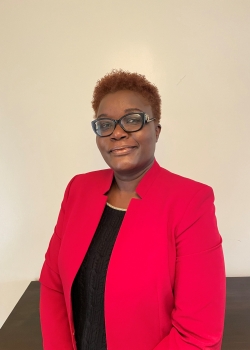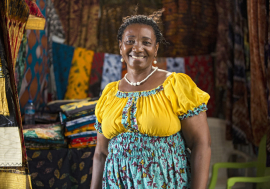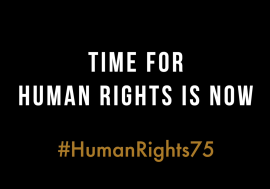Ahead of the UN Food Systems Summit on 23 September 2021, four levers of change were identified as having the power to bring about meaningful progress in food systems transformation and the achievement of all 17 Sustainable Development Goals (SDGs). One of the levers is Gender Equality and Women’s Empowerment, which is led by Dr. Jemimah Njuki, also the Director for Africa at the International Food Policy Research Institute (IFPRI). In this interview with Africa Renewal’s Franck Kuwonu, Dr. Njuki shares the concerns of women smallholder farmers and traders, and their expectations for the Summit.

You are a Food Systems Champion and officially the “Custodian for Gender Equality and Women’s Empowerment” for the upcoming Food Systems Summit. What is a custodian and what is your specific role?
There is a literal meaning of the word "custodian" because the Special Envoy [to the 2021 Food Systems Summit Dr. Agnes Kalibata] was clear about the role. The overall mandate was to work to ensure that gender equality and the empowerment of women and girls remain central to the process and outcomes of the UN Food Systems Summit, and specifically across the five-action tracks on ensuring access to safe and nutritious foods, shifting to sustainable consumption patterns, boosting nature-positive production, equitable livelihoods and resilience. The second mandate was to ensure that we have solutions to address systemic gender inequalities in food systems and to engage women across the world in developing these solutions.
Why is this Food Systems Summit important at this time?
This Food Systems Summit is needed because we are in the last decade of the SDGs and all the data tells us we are not on track to meet the Goals, including SDG 2 on ending hunger. And so, the Food Systems Summit at this particular time is very important. It's like you are running a race and you know that toward the end of the race is when you must sprint if you really want to win. And this is the sprint that we now must run.
So, the idea is how do you bring all the stakeholders of the food systems together to say ‘people, this is where we are.’ If we run at the same pace as we have been before, we are not going to achieve the target. We need to accelerate progress and we need to figure out how to do that.
What does a successful Food Systems Summit look like for you?
From a gender perspective, for the women around the world that I have been representing in this summit, a successful Food Systems Summit will be governments coming to the table with real commitments and resources to support women in food systems—in closing the gaps in financial inclusion that we know exist, guaranteeing land rights for women, and other solutions that address inequalities. There must be specific plans and resources and commitments to deal with some of those issues that women around the world have identified.
The second thing that would make the summit a success would be our global commitment to gender equality and women's empowerment in food systems, from the highest levels, from the Secretary-General himself [António Guterres] and from the Rome-based agencies [the Food and Agriculture Organization (FAO), the International Fund for Agricultural Development (IFAD), and the World Food Programme (WFP)] that have mandates for food and nutrition security, and from governments and other stakeholders.
And the third is for people to hear the voices of women and have very specific action plans after the summit. So, for me, a successful summit does not just focus on what happens during that one-day session but one that has a plan for pushing forward these commitments to gender equality.
You have been consulting extensively ahead of the Summit. Whom have you talked to? What have you shared with them and what did they tell you?
Our biggest constituency was women and girls. We held several dialogues in Africa, Latin America and the Caribbean and South Asia. There were also dialogues in Central Europe, bringing not just women and girls but also organisations that work on issues of women and girls, leaders of countries, and different groups of women and girls.
We brought together indigenous peoples; entrepreneurs, people who are trading in food; consumers, young men and women because they are the ones who are making our food systems move, and they know what the challenges are.
What we were pitching to them is this huge opportunity to raise their voices, to express what their priorities in the food systems are, what actions they would like to see from governments, from the global community, and from funders.
In each of these regions, the priorities were quite different. In Africa, land rights for women are key. Even in the countries where we have progressive constitutions, women's land rights are still a big issue. There was also the issue of access to technologies, including digital technologies, and financial products needed to close the gap that currently exists. And the third thing was legislative and institutional barriers that they want to see removed.
- Alliance for Anemia Action to address anemia in women and girls
- Global Food 50/50, a global accountability mechanism for tracking women’s leadership, polices and programs in food systems organizations
- Innovation hubs focused on profitable, nutritious foods (including indigenous crops) grown and traded by women
- Alliance of 50+ global and national financial institutions to implement gender-transformative financial inclusion for women
- Blended financing mechanism to small initiatives locally owned by women and youth,
- Land Rights for women and equitable community-based decision-making mechanisms and information systems on land rights, and access and control over essential food-producing resources
- Gender Transformative Approaches in food systems policies, programs, and systems (including extension systems)
- Alliance of countries adopting feminist food systems policies and regulatory frameworks that advance women’s leadership in local, sub-national and national levels, adopt gender-responsive budgeting, and include appropriate sex-disaggregated indicators and targets for measuring gender equality and women’s empowerment
- Global Data Hub for Enabling Gender Transformative Food Systems Policies.
- A campaign and program of work to tackle harmful social and gender norms, customs, and values that engages men and women, boys and girls together as agents of change at all levels.
In Latin America, it was issues of respecting indigenous food systems because they are grappling with problems of obesity. So, the question was how they can elevate their indigenous foods to become more accessible and available, including linking these local food systems to school feeding programmes.
In Southeast Asia, there was a lot of focus on informal women workers and smallholder women producers—how they organize to access markets and how governments should start seeing their farms and enterprises as businesses and recognize women as bonafide producers and business owners. These are some of the things that we were hearing. We have compiled all these into 10 action points that we will be presenting at the summit.
Was there anything you learned from the conversations and dialogues that surprised or challenged you?
I think there are many things that have challenged me. One of the things has been women telling us: ‘We are in the food systems. We have been in the food systems. We are doing our part in the food systems. We are producing. You go to the market it’s us who are trading. We are the ones running small and medium enterprises (SMEs). It is the systems that you have put in place that are not working for us. We are doing our part, but you need to fix these systems.’
You need to fix the financing so that it is developing products and services that meet our needs and priorities. You need to fix the policies so that we can own land and use the land as collateral to get finance. You need to fix big industries and companies so that they are providing decent jobs, paying equitable salaries. You need to address our unpaid care work burden. We are trying to produce food and at the same time take care of children with no basic infrastructure especially in rural areas.’ These, for me, were key messages that came through.
A lot of times we've been saying let's train women, let's do this for women. And this is still important. But women are very loud and clear that they are already in the food systems producing and trading, but that the systems in place are not serving their needs and priorities.
Would it be correct to say their expectation for the Summit is not aspirational but that there is agreement on practical solutions?
We need change and very practical things, and these are needed now. And when you see the 10 commitments that we have put on the table, they are very practical things that can be done. For example, we are calling for an alliance of financial institutions to develop products that work for the women who are in food systems because they are very different from women who are outside of the food systems. Their businesses are different, and their needs and priorities are specific.
Another practical recommendation is for organizations working in the food systems to report on an annual basis how many women are in leadership positions and what policies they have in place to make sure that women have decent jobs, as well as collect data on gender indicators and sex-disaggregated data that shows the impact of their work on men and women.
You have often said that countries where women are most marginalized and are discriminated against are the ones where people are the hungriest. How so?
The simplest way of saying this is, if you discriminate against women, for example in access to resources such as inputs, or when they have limited access to fertilizers because of financial reasons, or because your system discriminates against them, or if they cultivate land that they don't own and they know that these lands can be taken away, their investment in that land will be lower than the investments made by men.
If they have no access to finance because they have no collateral or walk into a bank and people see a woman and not an entrepreneur or they need a husband to co-sign a loan for them, then these women become less productive. And in some countries, there's data that shows that if you give them the same access, women could be 30 per cent more productive.
This means you end up producing less food as a country because it is like you are running with one hand tied behind your back. Those with both hands free are going to get there before you. So, it's the same logic, that we are having less productive women, not because they can't be as productive as men but because they don't have the same access to resources that men have, and you end up producing less.

One of the seven specific priorities of the summit will be women’s rights to land. Your research shows that land rights are complicated in developing countries and women usually lose out. How can a summit like this concretely address this issue?
There are two things here: the first is the legal provisions. We have only a few countries that allow men and women equal rights to land. We have a long way to go in making sure that legislative instruments that guarantee women's rights to land are in place. But for these countries, that women’s capacities are being built and they are being made aware of what those rights are so that they can claim them. This is very doable.
The second part, which is also very doable, are the socio-cultural norms. There's a belief system that sees you as a woman who cannot own land in your husband's home, or you cannot inherit your father's land. For example, in Kenya, we have one of the most progressive constitutions that guarantees equal rights to land ownership and inheritance, but since it was passed, only around 10 per cent of the titles have been granted to women. And the proportion of land owned by women is still below 2 per cent. So, even where the legal instruments are working, we know there's something else that needs to happen. Part of that is the implementation and changing these norms and beliefs around women's ownership of land. And that's where we need the engagement of the traditional leaders, and of men and boys.
The summit will also focus on unpaid care and the agricultural labour burden, access to technologies and economic empowerment of women in food systems. From your interactions with people, what is the general understanding of these priorities? Did you notice any significant movements toward action?
We are seeing some huge shifts in some of these areas, especially access to technology and services. But for some issues, progress is much slower. For example, the issue of unpaid care work is a much more complex one because it requires multiple strategies. First, it requires that governments recognize the value of unpaid care work because what is not valued is not planned for.
Second, it requires reducing the amount of unpaid care work. And this is where technologies help, making sure basic services like water and energy are accessible to people.
But there's a part of unpaid care work that we don't always think about especially for rural women. We think about energy, water, but not childcare. Childcare should be factored into governments’ planning for basic infrastructure. So, if you are building a market in an urban or a rural area, the same way you plan for toilets and water in a market, you should also plan for childcare because the women who come to those markets have children. It is difficult for them to trade and to carry things with children on their backs.
And third, it requires the redistribution of unpaid care work to be shared between men and women. And norms of childcare and domestic work need to change for this shift to happen.
Changing norms and addressing institutional barriers and promoting gender-responsive agriculture and food systems policies are the remaining priorities. What kind of norms are these?
I have talked about norms on women’s ownership of assets such as land, and norms on childcare. We also need policies to change so that they recognize women's roles and promote their leadership. We also need policies that adopt principles of gender budgeting, and that are tracking gender indicators and the empowerment of women. These are important elements that need to be mainstreamed in government.
Also, it is important that governments are thinking about the impact of all the policies on women and collect the data that allows us to track that impact.
What are the next steps after the Summit?
The next step after the summit is putting these commitments to action. We are putting together a multi-stakeholder coalition that includes governments, funding organizations, the Rome-based agencies and farmers' organizations. We are calling it the Coalition on Making Food Systems Work for Women and Girls because we now want to start implementing this 10-point action plan. We are looking to the Rome-based agencies to help us convene this coalition and for governments to come on board and lead because a lot of this action also must happen at the national levels.
What changes could smallholder women farmers see after the summit? When might they see them?
With this 10-point action agenda, when implemented, this is what is going to change for them: they will have governments that have gender responsive policies, that are budgeting for their wellbeing and that are tracking progress and impact on their lives. They will see an extension system that provides information to them and that recognizes them as bonafide farmers who deserve services from the government.
Women are going to a governor or an administrative or government planner in a rural area who designs a market that serves them who says ‘You are a woman with a child. This market has been designed so that it works for you.’ This needs to happen between now and 2030 because as I said, this is accelerating time. We are expecting governments to sprint to achieve the SDGs. It is not just the race to zero hunger, but also the race to zero gender inequality.




















